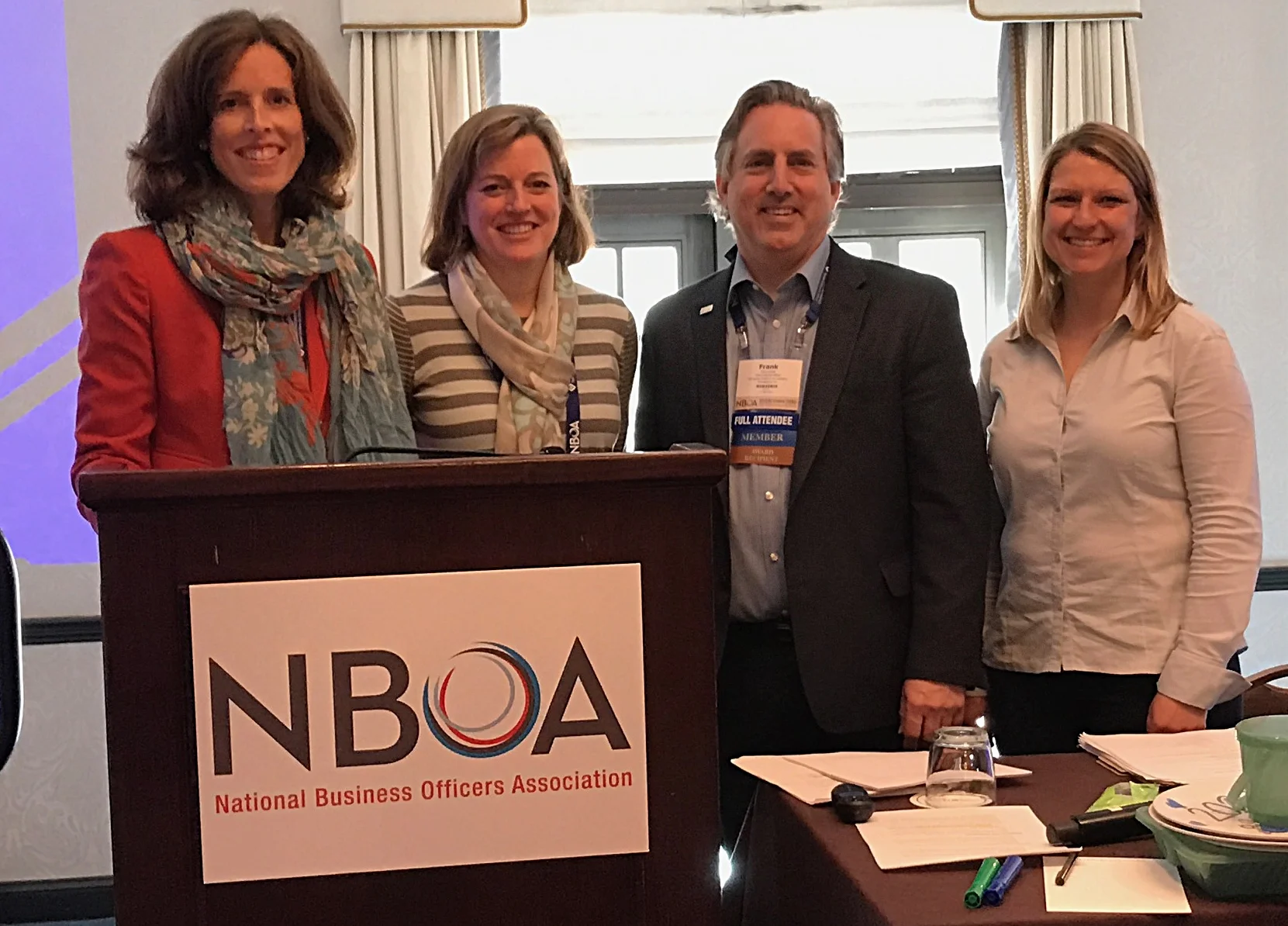On December 9, 2022, educators, policymakers, scientists, and family members across the nation met virtually via Zoom to discuss the intersection of sustainability and education at Women for a Healthy Environment’s 2022 Healthy Schools Summit.
MFS’s Physical Plant Team Saves Money, Time & Energy
Moorestown Friends School has completed several green initiatives that both increase efficiency and save money. MFS’s Director of Physical Plant, Julius “Jul” Trimbach, offered some insight on how to transition a school into a more eco-friendly place.
Sustainability Group Meets at SCH Academy for Campus Tour, Plant-Based Dinner, & Electronic Waste
Over 20 participants from 11 schools attended the PAISBOA Sustainability meeting at Springside Chestnut Hill Academy on October 27, 2022. The theme for the evening: “Getting Back to Where We Were Before Covid” related to environmental sustainability.
Celebrating Trees: Is Your School Arboretum-Worthy?
PAR Recycle Works: Improving Lives & the Environment
What do environmental sustainability, electronic waste, and the criminal justice system have in common? Employment opportunities in sustainability-related fields, known as “green jobs,” can help formerly incarcerated individuals to reenter society and successfully build their careers. Since 2016, People Advancing Reintegration (PAR) Recycle Works, a non-profit organization based in North Philadelphia, provides valuable job training and practical skills to formerly incarcerated people.
What the Inflation Reduction Act Means for Schools
Schools Re-imagine Outdoor Spaces
Studies show that being outside in nature has the ability to calm and heal. Spending as little as 15 minutes in nature lowers cortisol stress levels and blood pressure. Nature helps foster our creativity and observation skills. With the increase of screen time, we often forget to unplug and head outside.
Unplugged & Unstructured: Getting Children Outside
“Nature-Deficit Disorder”
While the full effect of pandemic-related behaviors on children is yet to be understood, the term “Nature-Deficit Disorder" by Richard Louv aimed to describe the human costs of alienation from nature and sequester a call to action. Since Louv popularized the term, there have been numerous studies on the impacts of nature experience on human development. Nature-deficit disorder suggests a host of adverse effects, including but not limited to; diminished use of the senses, increased attention difficulties, higher rates of obesity, and physical and emotional disorders.
Nature-deficit also indicates that we’re not preparing children to become stewards of the environment without a connection to the natural world. These issues lend themselves to more significant problems, which experts call “an inactivity epidemic.”
New York Times author, Meg St-Esprit McKivigan, ran this headline in June 2021: “Nature Deficit Disorder is a Thing,” stating, “Children’s behavior may suffer from lack of access to outdoor space, a problem heightened by the pandemic.” Unfortunately, her statement holds true. A 2020 report from the Centers for Disease told the same story depicting a nationwide surge in mental health crises during the pandemic.
Screen time has also increased. Studies conducted over the pandemic have found a consistent picture of elevated screen time in children of all ages, contributing to increased risks to physical health. The Journal of Neural Transmission reported total media time increased by 46% during the lockdown and did not ultimately return to pre-Corona levels.
Lean into Outdoor Opportunities
Child health and education advocates are working to inform the public about the positive health effects of time spent in nature. Educators and parents can lean into outdoor experiences and facilitate authentic, simple opportunities to improve health and well-being. Choose places and activities that are accessible and where you can often go, keeping it sweet and simple!
The natural world offers many opportunities to enjoy, learn, reflect and reset. Watching the exact landscape change from season to season is quite spectacular; imagine how a tree flourishes in the summer and quickly turns frosty in the winter. Give children time to watch, reflect, and understand the cycle of life in their way, promoting rapport and care for the planet!
The Benefits of Outdoor Experiences
Being outside has benefits that go far beyond the physical. Nature engagement can positively affect overall well-being and health. A study published by The National Institute of Health shows that being outside in nature helps to:
Reduce levels of stress hormone - cortisol
Improve concentration and recall
Improve sleep patterns
Improve mood and outlook
The importance of outdoor play has never been so clear, so take the extra moment to go outside with students and enjoy!
Nature observation © Jacob Land/Adobe Stock
by Simran Safer, Associate at Boyer Sudduth Environmental Consultants.
This article is also published in PAISBOA’s Friday Flyer, Vol XI, No. 8, May 13, 2022.
Westtown School Tackles Food Waste One Scrap at a Time
4 Tips to Shrink Your Lawn with Native Plants
Across the United States, manicured grass lawns blanket over 40 million acres posing serious threats to surrounding biodiversity and ecosystems (Audubon, n.d.). Grass lawns at schools and homes crowd out wildlife and native plants. They also require a lot of water, fossil fuels, and chemicals to maintain them.
American lawns consume:
Nearly 3 trillion gallons of water a year,
200 million gallons of gas (from mowing) and the noise from the mowers and string trimmers can be
70 million pounds of pesticides (NRDC, 2016).
Many lawns consist of just one species or “monocultures” (such as Bermuda grass from Africa) that is exclusively cultivated. A monoculture landscape lacks biodiversity to support beneficial pollinators like birds and butterflies.
Unsure how to reduce your impact whether at home or school? We’ve pulled together some eco-friendly tips on how and why native plants are good for us.
Tip 1: Start Small
Look for areas at your school or at home where the grass doesn’t grow in the first place – this can be steep banks, rocky outcroppings, shaded areas under the trees. Consider unused areas, such as front and side yards or buildings, where grass could be replaced with alternative plantings.
Once you’ve identified an area, spread a sheet of black plastic and place rocks over it. The weight will cause the grass to wither and the roots to dry up. After this, turn the top 12” of soil and use a hoe to break up the clumps. The area is now prepped and ready for native plants!
Tip 2: Choose Native over Exotic Plants
Go for a “natural” rather than formal look by choosing native plants that are conducive to your location (see “plant hardiness growing zone”). Native plants provide a host of benefits: they require low maintenance, help combat climate change, conserve water, and provide vital habitats for wildlife. Native plants create mutually beneficial relationships between the insects and bird populations. Exotic (non-native) plants disrupt these relationships, often harbor invasive pests, and require more maintenance.
Photo of blue-eyed grass (Sisyrinchium idahoense), a native groundcover
Invite Pollinators & Plant Native Species
Did you know that 35% of the world's food crops depend on animal pollinators to reproduce (USDA)? Pollinators perform crucial mechanisms to support ecosystems making it possible for our food and flowers to grow. Pesticides, drought, habitat destruction, and climate change threaten pollinators like insects and birds (Vassar, 2017). Consider supporting these important pollinators by planting native species such as perennials like coneflowers, cardinal flowers, milkweed, white wood aster, blue wild indigo, and Virginia bluebells. A landscape of native plants provides teachable moments where students can observe the interaction between plants and pollinators and learn the benefits of biodiversity.
Native flowers at Mt. Cuba botanical garden
When planting, it is important to consider the garden’s location, soil type, and potential native plants. While most flowers can grow in both sunny and shady locations, butterflies and other pollinators prefer wildflowers that grow best in full or partial sun. Also, depending on the location, the soil can be sandy and well-drained or more clay-like and wet, which will greatly affect the types of plants you can grow (FWS, 2003).
Tip 3: Ditch the Pesticides
Pesticides are chemicals designed to kill insects, plants, and fungi to create the ‘perfect’ lawn. However, they inadvertently pose a series of negative consequences. For instance, pesticide residue affects the quality and structure of the soil and leaches into the groundwater. Not to mention, it can be severely toxic for soil-living organisms. Lawn chemicals should also be avoided especially if there are children who play on it. The pesticide residue moves up through the food chain posing serious health consequences to a series of species including humans (Policy, USA).
Tip 4: Educate Others
Certify your school or yard with a sign that tells others about your habitat. Programs such as the National Wildlife Federation’s Wildlife Habitat, Audubon Mid-Atlantic, and the North American Butterfly Association offers a Butterfly Garden and Habitat Program. These programs provide excellent resources for how to certify your home or school garden. They also provide signage to educate others about the importance of biodiversity and native species.
National Wildlife Federation’s Certified Wildlife Habitat signs educate others about the importance of creating native habitat
A Call to Action
Our actions to improve native habitats can help to reduce the negative impacts of biodiversity decline. President Biden established a national goal to conserve at least 30% of US lands and freshwater and 30% of US ocean areas by 2030. This initiative is referred to as “30×30.” Our collective actions may seem small but together we can make positive change.
Additional Articles:
Article by Hannah Riegel, Boston College ‘22, Sustainability Intern at Boyer Sudduth Environmental Consultants.
Article printed in PAISBOA’s Friday Flyer Vol. XI, No. 6 - April 1, 2022
Sustainability Survey Results for PAISBOA Schools Are In!
Call for Participants in PAISBOA Sustainability Benchmarking Survey
Are you wondering how your school compares to others in issues regarding environmental sustainability or how you can make the next steps? Consider joining Boyer Sudduth and PAISBOA’s second annual School Sustainability Benchmarking Survey, a way to reflect and compare your school to peer institutions, while also having a chance to make progress in your school’s sustainability practices.
Sustainability in the Classroom: PAISBOA Sustainability Group January 26, 2022 Meeting
Inspire Students with Hydroponic Kits
No-Idling Promotes Good Stewardship & Environmental Practices
That’s a Wrap: Eco-Friendly Tips for the Holidays
More Plants, Less Waste: How Our Diet Affects Climate Change
Did you know that Americans waste a staggering 40% of our food (NDRC, 2017 )? Food waste in landfills contributes to the release of methane, a powerful heat-trapping gas 21 times more harmful than carbon dioxide. Mary Ann Boyer and Nate Buchanan of Boyer Sudduth Environmental Consultants presented “A Diet for the Climate” at Drexel University’s Academy of Natural Sciences to outline ways to reduce food waste and the carbon footprint of our diets. This presentation was part of a climate panel event, which attracted 119 participants on November 16, 2021.
In their presentation, Boyer and Buchanan highlighted the climate impacts of methane emissions from food in landfills and provided tips to limit our food waste.
Figure 1: Tips to limit food waste and reduce your food footprint.
They then addressed the carbon emissions from a meat-heavy diet. The chart below shows the carbon emissions of various foods. Beef is the highest, followed by cheese, pork, poultry and fish.
Figure 2: Greenhouse Gas Emissions by Food Type per pound of edible weight.
“Shifting our food choices to eat ‘lower on the food chain,’ opting for less carbon intensive poultry or fish, can help reduce our emissions,” noted Boyer. “Eating a plant-forward diet is better for our health and the planet.”
Boyer and Buchanan then outlined tips to eat a plant-forward diet. “We’re not asking everyone to become vegetarians or vegans overnight, but that they consider eating more plants and less meat,” added Buchanan.
Figure 3: Tips for Eating a Plant-Forward Diet.
If you want to embrace a plant-forward diet, start small. Going one day a week without meat (like a “Meatless Monday”) or trying out a plant-based burger are some excellent first-steps to start eating plant-forward. It is critical to remember that every small dietary change can have a positive climate impact.
For more information, see these tips to reduce our food footprint. After Boyer and Buchanan’s presentation, Bob Ellis of the Climate Reality Project, presented on the state of the climate crisis. To view the full panel and presentations, click here.
Blog by Nate Buchanan, Haverford College ‘22, Sustainability Intern at Boyer Sudduth Environmental Consultants.
Learning Outside the Classroom: PAISBOA Sustainability Group Meets at Germantown Academy
OASIS’s Fall Meeting: “Creating a Culture of Hope”
On October 21, 2021, 41 participants joined virtually for OASIS’s Sustainability Group first fall meeting featuring guest speaker, Brian Dunbar, Executive Director of the Institute for the Built Environment and Professor Emeritus at Colorado State University. Dunbar’s theme “Creating a Culture of Hope” embodied two big ideas: Whole School Sustainability and Regenerative Future.



























